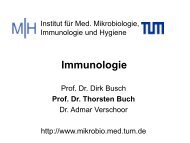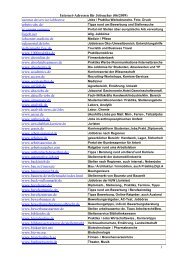Institut für Entwicklungsgenetik Institute of Developmental Genetics ...
Institut für Entwicklungsgenetik Institute of Developmental Genetics ...
Institut für Entwicklungsgenetik Institute of Developmental Genetics ...
You also want an ePaper? Increase the reach of your titles
YUMPU automatically turns print PDFs into web optimized ePapers that Google loves.
<strong>Institut</strong> <strong>für</strong> <strong>Entwicklungsgenetik</strong><br />
<strong>Institut</strong>e <strong>of</strong> <strong>Developmental</strong> <strong>Genetics</strong> (IDG)<br />
Neuropsychiatric Disease Modelling & Mouse <strong>Genetics</strong> – Pr<strong>of</strong>. Dr. Wolfgang Wurst<br />
Neuronal Circuits – Dr. Andrea Huber-Brösamle<br />
Eye Disease – Pr<strong>of</strong>. Dr. Jochen Graw<br />
Stem cells in Neural Development – Dr. Sabrina Desbordes<br />
Molecular Neuroimaging – Dr. Gil Westmeyer<br />
www.helmholtz-muenchen.de/en/idg
Research themes at the IDG<br />
• Understanding neural development and stem cell biology<br />
– Dissection <strong>of</strong> molecular networks underlying midbrain dopaminergic neuron<br />
generation and survival in vitro and in vivo (animal models)<br />
– Dissection <strong>of</strong> molecular networks controlling neurogenesis, neuronal migration and<br />
neuronal circuit formation using animal models<br />
• Understanding the etiology <strong>of</strong> human diseases<br />
– Dissection <strong>of</strong> genetic pathways underlying neurological (Morbus Parkinson &<br />
Alzheimer) and psychiatric (depression, anxiety) diseases using animal models<br />
– Dissection <strong>of</strong> genetic pathways underlying eye disorders using animal models<br />
• Functional dissection <strong>of</strong> the mouse genome<br />
– Generation <strong>of</strong> isogenic cell lines/induced pluripotent (iPS) cells and mice using<br />
TALEN technology<br />
– Saturation mutagenesis <strong>of</strong> the mouse genome by conditional targeting vectors
AG Wurst/Prakash: Disease Modelling-Neuronal differentiation & maintenance<br />
NG Desbordes: Disease Modelling – Stem cells in neural development<br />
Midbrain Dopaminergic Neuron Development<br />
I. Signaling pathways underlying the development <strong>of</strong> mDA neurons<br />
II. Stem cell therapies for neurodegenerative disorders (Parkinson)<br />
ES/iPS cell differentiation<br />
(Prakash & Desbordes)<br />
Recruitment <strong>of</strong> endogenous stem<br />
cells & direct reprogramming<br />
(Prakash)<br />
Undifferentiated EScells<br />
Dopaminergic<br />
neurons<br />
Which factors<br />
Endogeneous<br />
stem cells<br />
Dopaminergic neurons<br />
Transplantation <strong>of</strong><br />
stem cells
AG Wurst/Vogt: Disease Modelling – Parkinson‘s Disease<br />
AG Wurst/Floss: Disease Modelling – Dementia (Alzheimer, FTLD, ALS)<br />
Animal models for neurodegenerative diseases<br />
I. Animal models for Parkinson’s disease<br />
II. Animal models for Alzheimer’s disease, FTLD, ALS<br />
A<br />
Genetic animal<br />
models<br />
German mouse<br />
clinic<br />
Clinical<br />
Phenotype<br />
Mental<br />
Health<br />
Ageing<br />
Ageing mouse<br />
cohorts<br />
B<br />
2<br />
1<br />
2<br />
Sample phase:<br />
1<br />
familiar subject<br />
(2) is introduced<br />
to the tested<br />
animal (1)<br />
Social Discrimination test<br />
2<br />
hours<br />
break<br />
2<br />
Test phase:<br />
unfamiliar subject<br />
(3) together with<br />
mouse (1) and (2)<br />
1<br />
3<br />
investigation duration [sec]<br />
100<br />
90<br />
80<br />
70<br />
60<br />
50<br />
40<br />
30<br />
+/+ -/-<br />
***<br />
2<br />
10 0<br />
0<br />
Sample phase test phase Sample phase test phase<br />
- -<br />
n.s.<br />
Neurodegenerative diseases are<br />
multifactorial diseases<br />
familiar subject unfamiliar subject<br />
ANALYSIS AT MORPHOLOGICAL AND BEHAVIORAL LEVEL
AG Wurst/Deussing: CCG Molecular Neurogenetics (MPI <strong>of</strong> Psychiatry)<br />
The role <strong>of</strong> the CRH/glucocorticoid system in depression<br />
I. Generation/analysis <strong>of</strong> mouse models for anxiety/depression<br />
II. Molecular pathways altered in Depression<br />
Dunkles Abteil<br />
(3 lux)<br />
wildtype<br />
CRH-R1-ko<br />
Helles Abteil<br />
(700 lux)<br />
Inactivation <strong>of</strong> the CRHR1 in the<br />
limbic system<br />
CRHR1-deficient mice are less anxious<br />
Psychischer Stress Physischer Stress<br />
Stressbedingter<br />
Alkoholkonsum<br />
ethanol intake (g/kg/day)<br />
5<br />
4<br />
3<br />
2<br />
1<br />
*<br />
*<br />
0<br />
0 pre1 pre2 post1 post2 post3<br />
post20<br />
Post30
AG Wurst/Kühn: Mouse <strong>Genetics</strong> – Genetic Tools Development<br />
New technologies in mouse genetics<br />
I. Generation <strong>of</strong> isogenic cell lines and mice using TALEN technology<br />
II. Generation <strong>of</strong> mouse mutants with inducible signaling proteins<br />
TALEN technology - Highly specific and versatile
AG Huber-Brösamle: Neuronal Circuits<br />
Neuronal Circuit Formation in the Spinal Cord<br />
I. Novel factors guiding sensory and motor axons<br />
II. Molecular basis <strong>of</strong> communication between fiber systems<br />
development<br />
environment<br />
disease<br />
physiology<br />
genetics<br />
Regeneration and adaptive plasticity in the nervous system
AG Graw: Eye Diseases<br />
Principles <strong>of</strong> eye development and eye disorders<br />
I. New genes for eye formation<br />
II. Mouse eye mutants as models for neurological and psychiatric disorders<br />
The new gene belongs to the<br />
Connexin-family: gene<br />
symbol Gjf1 (gap junction f1)<br />
The mutation affects the first<br />
transmembrane domain<br />
Aey12: dominant mutation,<br />
„small eyes“<br />
Positional cloning: Chr. 10<br />
Primary lens fiber (PLF) do not elongate from the<br />
posterior side <strong>of</strong> the lens vesicle<br />
Functional analysis started in<br />
cooperation with Dr. Musil<br />
(Portland/USA)<br />
Prepulse Inhibition<br />
PPI %<br />
100<br />
80<br />
60<br />
40<br />
20<br />
+/- male<br />
-/- male<br />
+/- female<br />
-/- female<br />
Mutations in Crybb2 coding for bB2-crystallin<br />
and leading to progressive cataracts 0377<br />
(Philly) is also expressed in the brain<br />
0<br />
67 69 73 81 global<br />
PP intensity (dB)<br />
[Startle 110dB]<br />
Prepulse inhibition as indicator for schizophrenia
Lehrveranstaltungen des IDG / IEG<br />
Bachelorstudiengang:<br />
• Vorlesung <strong>Entwicklungsgenetik</strong> (in Zusammenarbeit mit IEG)<br />
– Inhalte: „Von der Befruchtung zum ausgewachsenen<br />
Wirbeltier“<br />
• Befruchtung, Musterbildung, Differenzierung<br />
• Organentwicklung<br />
• Alterungsprozesse<br />
– Wintersemester / Ort und Zeit siehe TUMonline<br />
– 2 SWS<br />
– ECTS 3<br />
– Schriftliche Abschlussklausur<br />
– Pflichtveranstaltung
Lehrveranstaltungen des IDG / IEG<br />
Bachelorstudiengang:<br />
• Vorlesung Genomics (in Zusammenarbeit mit IEG; Genetik)<br />
– Inhalte: Techniken und Anwendungen neuester Methoden<br />
• Genomics, Proteomics, Metabolomics<br />
• Quantitative genetics<br />
• Animal models<br />
• Databases<br />
– Wintersemester / Ort und Zeit siehe TUMonline<br />
– 2 SWS<br />
– ECTS 3<br />
– Schriftliche Abschlussklausur<br />
– Pflichtveranstaltung
Lehrveranstaltungen des IDG / IEG<br />
Bachelorstudiengang:<br />
• Praktika am IDG<br />
– Forschungspraktikum Neurogenetik<br />
• Mitarbeiter in einem Forschungsprojekt am <strong>Institut</strong><br />
• 6-wöchig, ganztägig<br />
• ECTS 10<br />
• Abschluss: 10-seitiger Bericht<br />
• Anmeldung jederzeit – siehe TUMonline<br />
– Blockpraktikum <strong>Entwicklungsgenetik</strong> der Tiere (mit IEG)<br />
• „From Genes to Phenotypes“<br />
• Blockveranstaltung 3-wöchig in Semesterferien (März)<br />
• ECTS 5<br />
• Abschlussklausur<br />
• Verbindliche Anmeldung bis Mitte Januar – siehe TUMonline<br />
• Beschränkte Teilnehmerzahl
Lehrveranstaltungen des IDG / IEG<br />
Masterstudiengang:<br />
• Vorlesung Neurogenetik I und II<br />
– Inhalte: Entwicklung/Funktion bestimmter Strukturen im<br />
ZNS (Neurogenetik I)<br />
• Neurogenese, Synaptogenese, axonales „pathfinding“<br />
• Neurotransmitter, Rezeptoren, Elektrophysiologie<br />
• Rückenmark, Kleinhirn, Basalganglien, Kortex<br />
– Inhalte: Störungen/Erkrankungen des ZNS<br />
• ALS, Ataxien/Medulloblastom, Parkinson, Schizophrenie,<br />
Alzheimer, Prionerkrankungen, Angsterkrankungen, Depression<br />
– Wintersemester (I)/Sommersemester (II)/ Ort und Zeit<br />
siehe TUMonline<br />
– 2 SWS, ECTS 6<br />
– Schriftliche Abschlussklausur, Wahlveranstaltung
Pr<strong>of</strong>. Dr. Jochen Graw<br />
Vorlesung:<br />
Humangenetik <strong>für</strong> Biologen<br />
16 Doppelstunden, WS 2009/2010, 4 ECTS-Punkte<br />
Beginn: 30.10.2009; 8:30 Uhr; Ort: Seminarraum O20<br />
Abschlussklausur: 5. 3. 2010; Ort: HMGU<br />
Praktika:<br />
Seminar:<br />
Forschungspraktika zum Thema „Genetik“<br />
incl. Möglichkeit <strong>für</strong> Masterarbeiten<br />
Themen: Mausmutanten mit erblichen Augenerkrankungen<br />
„Aktuelle Themen der Genetik“<br />
gemeinsam mit anderen zu den Themen der <strong>Entwicklungsgenetik</strong><br />
und der molekularen Maus- und Humangenetik<br />
Helmholtz Zentrum München<br />
Deutsches Forschungszentrum <strong>für</strong> Gesundheit und Umwelt<br />
<strong>Institut</strong> <strong>für</strong> <strong>Entwicklungsgenetik</strong><br />
Arbeitsgruppe <strong>für</strong> Molekulare Augenentwicklung<br />
85764 Neuherberg<br />
Tel: 089/3187-2610<br />
Fax: 089/3187-4620<br />
e-mail: graw@helmholtz-muenchen.de<br />
Internet: http://www.helmholtz-muenchen.de/en/idg/group-molecular-eye-development/
Lehrveranstaltungen des IDG / IEG<br />
Bachelorstudiengang:<br />
• Seminare am IDG<br />
– Seminar: Aktuelle Probleme der Genetik<br />
• Diskussion anhand von Literatur über interessante<br />
Forschungsergebnisse aus der Genetik<br />
• Wintersemester<br />
• SWS 2 – 1 tägig<br />
• ECTS 3<br />
• Abschluss: 10-minütiger Vortrag<br />
• Anmeldung siehe TUMonline
Lehrveranstaltungen des IDG / IEG<br />
• BACHELOR-/MASTERARBEITEN nach<br />
Absprache<br />
– Praktikum Neurogenetik ist wünschenswert<br />
– Vorlesung Neurogenetik I und II wünschenswert (<strong>für</strong><br />
Masterarbeiten)
Rückfragen/Absprachen:<br />
elisabeth.guell@helmholtz-muenchen.de<br />
oder<br />
www.helmholtz-muenchen.de/en/idg





